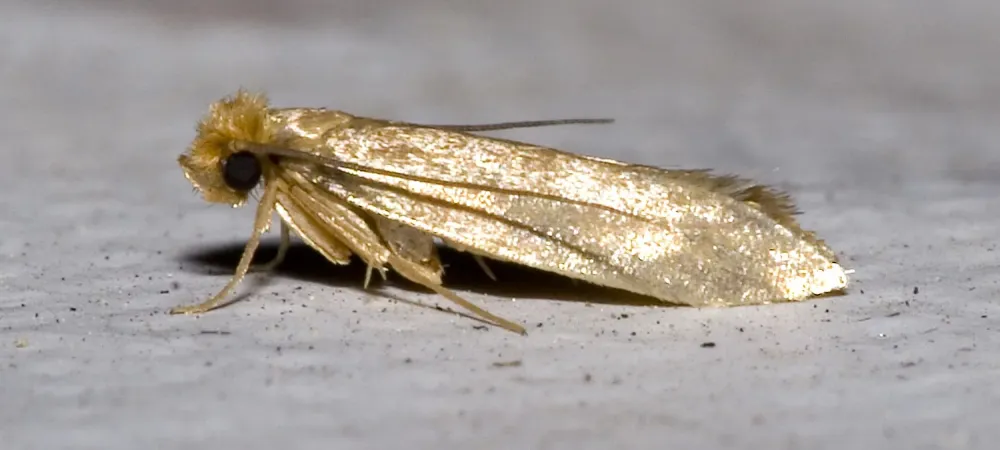Are Clothing Moths A Problem?

Clothing moths are destructive creatures that tend to hide when disturbed, so you might go for a long period before realizing you have a problem. If you want to keep your fabric, fur, and feathered items safe, it is a good idea to know what these destructive pests look like, both in their adult stage and in their larval stage.
WHAT DO CLOTHES MOTHS LOOK LIKE?
The most common type of clothing moth is the webbing clothes moth. The adult is only about 1/2 of an inch long, with amber or brown coloring and golden, 1/4 inch long gingery hairs along its wings. Unlike other varieties of moths, they aren’t very good at flying and aren’t attracted to light. You will usually find them close to infested areas, such as in dark closets where your treasured clothing items are stored. These moths only flutter in short bursts and it’s not uncommon to find them crawling rather than flying.
Clothing moth larvae are creamy-white colored larvae that can be as long as ½ an inch. They can also be identified by their feeding tunnels of silk, or webbing patches left behind on fabric, as they move around.
Where these moths are and their flying habits is actually the easiest way to determine what kind of moth you have. If they are in your clothes closet, they are clothing moths. Also, they tend to flutter about rather than fly in a steady, direct manner. These moths should not be confused with common food-infesting moths, which tend to fly all around the structure they are infesting and do not have the red-gold tuft of hair on their heads.
WHERE DO CLOTHES MOTHS COME FROM?
Moths can enter homes in many different ways. Because they like dark places, they sometimes hide in storage containers or food boxes and then are carried in from the store. They can also squeeze their way through cracks in floors and foundations, or through holes in window screens.
Moths in the larvae stage spend all their time eating and gathering sustenance. These moth babies, the cream-colored, silken larvae, are the ones that damage fabrics and clothes. These ravenous little creatures chew through fibers, eating many times their weight in a week. Then, like butterflies, they weave cocoons which they stay in for weeks before emerging as full-grown moths.
Moth mothers typically leave their larvae in places with a ready food supply: closets, dressers, within the folds of curtains, or underneath items that rest upon rugs and carpets.
WHAT DO CLOTHING MOTHS EAT?
Larvae are attracted to animal fibers like wool and fur, but they can chew through just about any kind of fabric or cloth. They are attracted to the animal smells we leave traces of on our clothing, like sweat and hairs that fall off onto sweaters and jackets. Adult clothing moths don't OR damage clothing. But, even though they don't do damage, they are still a problem. Their purpose is to lay eggs. The more eggs they are able to lay, the more eggs you'll have hatching inside your home, and the more fabric-eating larvae you'll have crawling around.
Types of fabric these larvae feed on include the most expensive of items, such as woolen garments and cashmere sweaters. They will also put holes in antique rugs, tapestries, curtains and many other types of fabric and clothing. It is important to note that female moths will look for dirty fabrics for oviposition, or egg laying. They are particularly attracted to fibers that contain human sweat or other decomposing organic matter. This is essential for larval development.
WHAT CAN YOU DO TO PREVENT CLOTHING MOTHS?
The best method for keeping clothes moths out of your home is prevention. Keep clothing storage areas clean and clutter-free so as not to be attractive for moths to deposit their young there. Frequently sweeping and vacuuming floors and rugs is another good way to curb the build-up of material that attracts moths.
GET RID OF CLOTHING MOTHS
While keeping clothing areas clean, putting clothing in plastic bags, and regular vacuuming will help keep clothing moths at bay, when you already have an infestation, it is advisable to partner with a pest control company to completely take care of the problem. Witt Pest Management can help. The educated professionals here at Witt, know how to completely address clothing moth infestations, and arrest the damage being done. If you're located near Pittsburgh, PA, reach out to us today for immediate assistance.
